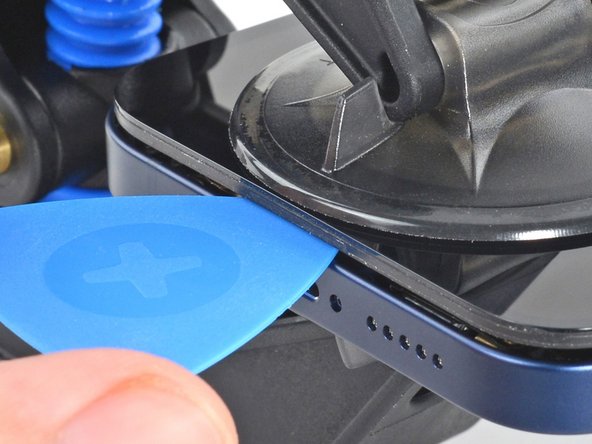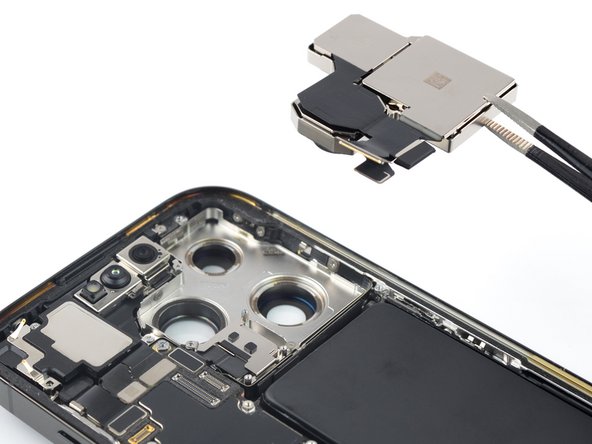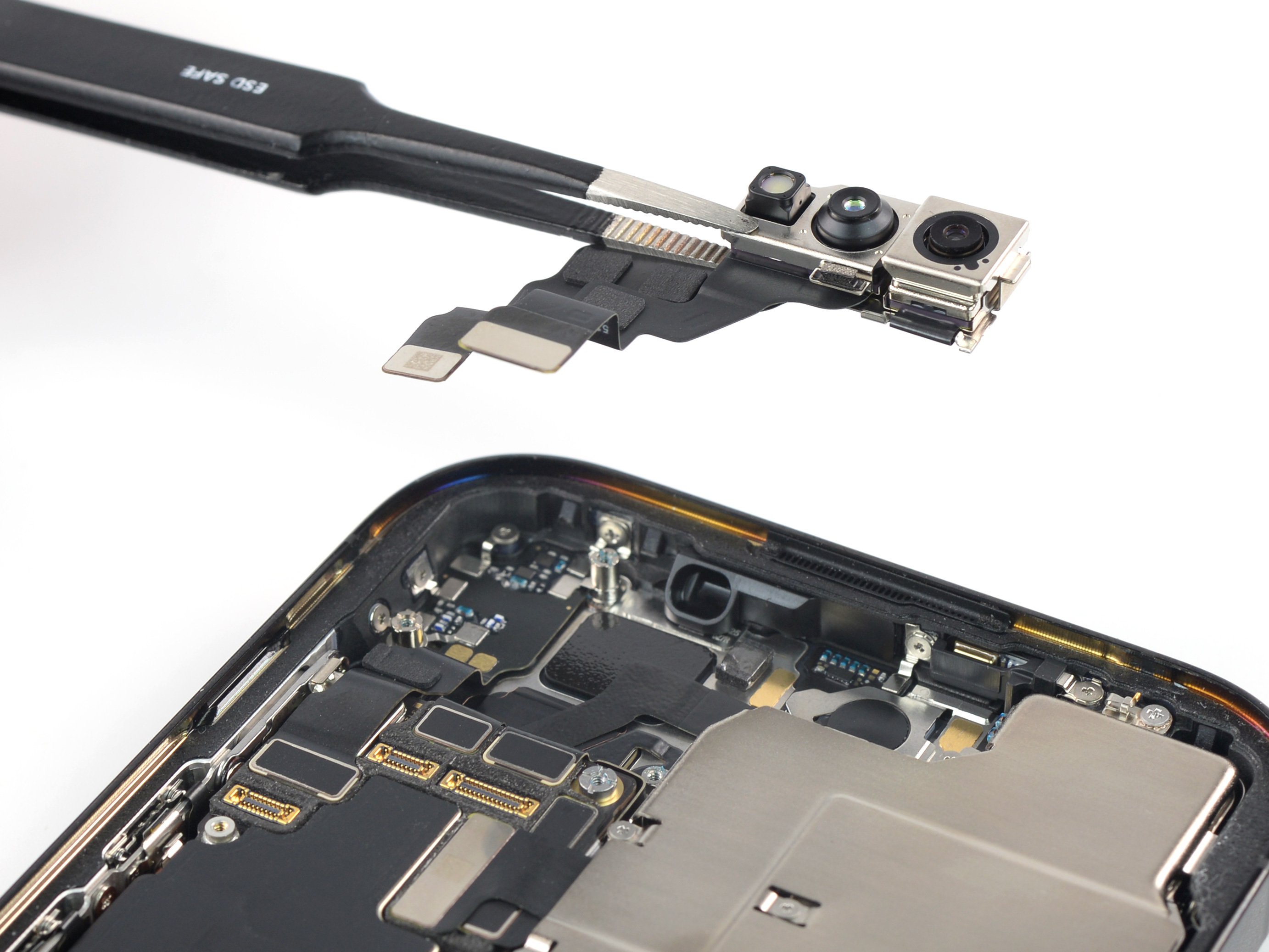iPhone 14 Pro Lidar Sensor Replacement
Duration: 45 minutes
Steps: 33 Steps
Dive into this guide to skillfully remove or swap out the lidar sensor in your iPhone 14 Pro! We crafted this using the A2890 (international) model, but if your iPhone 14 Pro is a different flavor, don't sweat it—while you might notice a few visual differences, the steps will still be your trusty companions. Just a heads-up: when putting your iPhone back together, you'll need some replacement adhesive to ensure that screen stays snug as a bug. And remember, keeping that water resistance after the fix relies on how well you reapply the screen adhesive, but fair warning—your device may lose its official IP (Ingress Protection) rating. If you need help, you can always schedule a repair.
Step 1
- Make sure to power off your iPhone before you start taking it apart.
- Next, grab your screwdriver and remove the two 6.8 mm pentalobe P2 screws located at the bottom edge of your iPhone.
Step 2
Be careful not to shove that opening pick in too deep, or you might give your device a little love tap it doesn't want! A quick tip: mark your pick to keep things safe and sound.
Feel free to jazz up the other corners of your pick with different measurements for added precision.
Or, get creative! Tape a coin about 3 mm from the tip of your pick for a handy measurement guide.
- Grab your opening pick and make a mark with a permanent marker exactly 3 mm from the tip—like setting a tiny finish line for your tool!
Step 3
Put on those safety glasses to keep your peepers safe from any sneaky bits of glass that might pop out during the repair!
Got a cracked iPhone screen? Keep those shards in check and avoid any ouchies by taping over the glass before you dive into the repair.
If the suction cup just won’t stick, try giving it a little boost by supergluing it to the screen.
- Cover the iPhone's screen with overlapping strips of clear packing tape until the entire front is nicely wrapped.
- If the suction cup refuses to stick in the next steps, no worries! Just fold a sturdy tape (like duct tape) into a little handle and use that to gently lift the screen instead.
Tools Used
Step 4
The next three steps will show you how to use the Anti-Clamp, our nifty little tool designed to make opening your device a breeze. If you're not using the Anti-Clamp, feel free to skip ahead three steps for an alternative method.
Need a hand with the Anti-Clamp? Check out this handy guide for all the details.
If you find your iPhone's surface is a bit too slick for the Anti-Clamp to grip, don't fret! Just use some tape to make it a little stickier.
- Pull the blue handle back to unlock the Anti-Clamp’s arms—time to get those hands in action!
- Slide the arms smoothly over either the left or right side of your iPhone. It's like giving it a little hug.
- Place the suction cups just below the iPhone's bottom edge—one on the front, one on the back. Perfect placement is key!
- Gently squeeze the cups together to create suction. They’ll stick where you need them, no problem!
Step 5
- Slide the blue handle forward to lock those arms in place. Trust me, they’re going nowhere.
- Give the handle a full spin clockwise, or until you see the suction cups start to stretch like they mean business.
- Keep an eye on those suction cups! If they start to wander apart, loosen them up a bit and line the arms back up so everything stays centered.
Step 6
Give it a gentle twist—no more than a quarter turn! Then kick back for a minute before you go again. Let the Anti-Clamp do its thing; patience is your secret weapon here.
For all the nitty-gritty details on how to wield that hair dryer like a pro, be sure to check out this handy guide.
If the Anti-Clamp isn't creating enough space, don't fret! Just apply a bit more heat to the area and give that handle a little twist—about a quarter turn should do the trick.
- Set your iPhone on something sturdy—think hardcover book vibes—so it stays hands-free and nice and level. Trust me, your wrists will thank you.
- Grab your hair dryer and aim it along the bottom edge of the iPhone. You're going for 'just a bit too hot to touch,' not 'roasting marshmallows.'
- Hang tight for about a minute so the sticky adhesive starts to loosen up and a gap shows up.
- When the Anti-Clamp has made a big enough gap, slide an opening pick under the plastic bezel of the screen. Channel your inner ninja—gentle but precise.
- Skip the next two steps. Seriously, you’re good to move forward.
Tools Used
Step 7
Keep that hair dryer moving—parking it in one spot too long is a no-go!
Got your suction handle ready? Keep rolling—next up, we’re going to loosen that screen.
- Grab a hair dryer or heat gun and gently warm the bottom edge of your iPhone for about 90 seconds, or until it feels just a bit too hot to touch. Don't worry, you're not going to burn anything—just give it enough heat to loosen things up.
Tools Used
Step 8
The adhesive keeping your screen snug and secure is quite the powerhouse; creating that initial gap requires some serious elbow grease. If you're struggling to pry it open, try giving it a bit more heat and gently wiggle the screen up and down to loosen that adhesive until you can slide your tool in there. You've got this!
- Grab your trusty suction handle and stick it to the bottom edge of the screen—just don’t get too close to the glass edge.
- Give that suction cup a solid, steady pull to make a small gap between the screen and the frame. Slow and steady wins here.
- Slide an opening pick into the gap right under the plastic bezel of the screen. Take it easy and let the pick do the work!
Tools Used
Step 9
- Grab a hair dryer and warm up the right edge of your iPhone (the side with the power button) for about 90 seconds or until it feels just a bit too toasty to touch.
Tools Used
Step 10
Keep your pick shallow—no deeper than 3 mm—to avoid poking anything important inside.
- Gently slide that trusty opening pick around the bottom right corner of your iPhone to break free from its adhesive bonds.
- Keep sliding up along the right edge of the iPhone until you reach the top right corner, like a pro!
- Once you hit the top right corner, leave that pick in place and get ready for the next step.
Step 11
- Grab that trusty hair dryer and warm up the top edge of your iPhone for about 90 seconds. You want it just hot enough that it feels a tad too toasty for your fingers.
Tools Used
Step 12
Keep your pick shallow—no deeper than 3 mm—or those top sensors might throw a tantrum.
- Gently slide the opening pick around the top right corner of your iPhone to break free that stubborn adhesive.
- Once you've got a spot, leave the pick in the top left corner so you can keep cruising along.
Step 13
- Grab your trusty hair dryer and give the left edge of your iPhone a warm hug for about 90 seconds or until it feels just a tad too toasty to touch. Let's get that screen ready for some action!
Tools Used
Step 14
Heads up! The left edge of your iPhone is home to some delicate cables—steer clear with your pick to avoid any cable drama.
Step 15
Be careful with those cables on the left edge! They're a bit delicate and could get hurt with a pick. Let's take a different route to tackle that left adhesive.
Ease into the twist—no need to rush.
If the adhesive is being stubborn, give the left edge another round of heat.
- Slip a second opening pick into the bottom left corner of your iPhone—like you're giving it a cool sidekick.
- Now, twist both picks at the same time. As you do, the left edge clips will pop free. Teamwork makes the dream work!
Step 16
No fancy props nearby? Your suction handle makes a perfect stand-in to support the screen — quick thinking!
- First up, gently detach your suction handle from the screen. No need to be rough with it!
- Next, give your iPhone a little spin so the right edge is facing you. You're doing great!
- Now, it's time to open your iPhone! Swing the screen up from the right side, just like you would with the cover of a book. Easy peasy!
- While you're at it, lean the screen against something sturdy to keep it propped up. This way, you can focus on the fun stuff!
- When it's time to put everything back together, lay the screen back in place, align those clips along the top edge, and gently press the top edge down. Snap the rest of the screen into position. If it doesn’t click into place right away, don’t fret! Just check the clips around the edge and make sure they're not bent. You've got this!
Tools Used
Step 17
As you tackle this repair, remember to keep an eye on each screw and return it to its original home. This little tip helps keep your iPhone safe and sound!
- Grab your Y000 screwdriver and take out the eight screws holding down the battery connector cover. Yes, this tool is as tiny as it sounds.
- Before you close things up, power on your iPhone and check that every feature is working like a charm. Once you’re done, make sure to turn it off completely before moving forward—your phone deserves a nap.
- Remove five screws, each measuring 1.3 mm. They’re small but mighty.
- Take out two screws that are each 1.6 mm long. Blink and you’ll miss them.
- Finish up with the lone 1.9 mm screw. It’s the big sibling in this tiny screw family.
Step 18
- Grab the connector cover with tweezers and slide it down like you're shimmying at a dance party—just enough to clear those flex cables.
- Lift off the connector cover and set it aside like a pro.
Tools Used
Step 19
Be gentle with the black silicone seal that hugs the board connections! These little heroes work hard to keep out water and dust, so let's give them the love they deserve.
- Grab the sharp end of your spudger and gently pry the battery cable connector straight up from its socket to unplug it.
- Give the connector a little wiggle away from the logic board so it won’t accidentally touch the socket and send power back to the phone while you’re working.
Tools Used
Step 20
- Grab the pointed end of your spudger and gently pop up the first display cable connector. Straight up is the way to go—no sideways shenanigans.
- To reconnect, line up the connector just right, then press down on one edge until it snaps in, and do the same for the other side. Skip the middle; pressing there can twist the pins, and nobody wants that kind of drama.
Tools Used
Step 21
- Grab the pointy end of your spudger and gently pop up the second display cable connector, lifting it straight out of its socket like a pro.
Tools Used
Step 22
- Take off the screen—gently now, no Hulk moves needed.
- Clean up the area with isopropyl alcohol (over 90% is the sweet spot), then slap on some fresh adhesive wherever it’s looking sparse.
- If you’re swapping out screen adhesives, hit pause before putting everything back together.
Step 23
- Grab your Y000 driver and unscrew the five tiny screws holding down the rear-facing camera assembly cover:
- Tackle one 1.7 mm-long screw with your Phillips screwdriver.
- Spin out four 1.5 mm-long Y000 screws.
- Don’t forget the lone 1.3 mm-long Y000 screw hanging out by itself.
Step 24
Check out the tiny metal edge hanging out in the top right corner of the rear camera cover—it's held in place by the frame.
When you're putting things back together, make sure that metal edge is lined up and popped right back into its little nook in the frame.
- Snag the rear camera assembly cover with your tweezers—like you're catching a tiny treasure.
- Slide the cover toward the volume buttons to wiggle that little metal edge out from its cozy spot in the frame.
- Lift off the rear camera assembly cover and set it aside like the pro you are.
Tools Used
Step 25
- Grab your trusty spudger and gently pop the ultra wide and telephoto lens cable connector straight up out of its socket. Easy does it—no need to rush!
Tools Used
Step 26
- Grab your trusty spudger and gently pry the wide lens cable connector straight up from its socket to unplug it. Easy does it!
Tools Used
Step 27
- Slide the sharp end of a spudger right under the bottom edge of the rear-facing camera assembly. You've got this!
- Gently pry up with the spudger to release the rear-facing camera assembly. Keep it steady and watch the magic happen!
Tools Used
Step 28
- Grab a trusty pair of tweezers or just your fingers and gently pop off that rear-facing camera assembly. You've got this!
Tools Used
Step 29
- Grab your trusty standoff screwdriver and gently unscrew the 2.8 mm standoff screw that’s holding the lidar sensor cover in place. You've got this!
Step 31
- Grab your trusty spudger and gently lift the lidar sensor cable connector straight up from its socket. You've got this!
Tools Used
Step 32
- Slide the flat end of your trusty spudger under the top edge of the lidar sensor.
- Gently pry upward with the spudger to free the lidar sensor from its spot.
Tools Used
Step 33
- If possible, power up your device and give your repair a test run before slapping on that new adhesive and sealing everything up tight.
- Take a moment to compare your shiny new replacement part with the original—don't forget to move any leftover components or peel off those pesky adhesive backings from the new part before diving in.
- To put your device back together, just retrace your steps in reverse order. It's like a fun little puzzle!
- Make sure to recycle your e-waste responsibly by bringing it to an R2 or e-Stewards certified recycler.
- Things didn't go as smoothly as you hoped? No worries! Try some basic troubleshooting or reach out to our Answers community for a helping hand.
- If you find yourself in a pickle, don’t hesitate to schedule a repair. We're here to help!





















































































